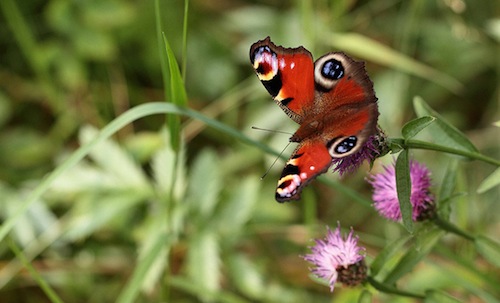 Peacock butterflies emerge into the sunshine from their winter sleep in the spring.
Peacock butterflies emerge into the sunshine from their winter sleep in the spring.
Photo: © Natural England/Paul Lacey
Scientific name: Aglais io (synonym: Inachis io)
Other common names: European Peacock
Cornish name: ‘Tikki-dui’ is the general word for butterfly
Conservation status: Not considered threatened
What to look for:
- Colouring : Red wings with large eye on each of its four wings. The eye is predominantly blue on the hind wings and yellow and blue with a red centre on the fore wings. The underside of the wings is a very dark brown. Caterpillars are black with a scattering of tiny white spots and spines.
- Size : A wingspan of 5.6 to 6 cm (males are slightly smaller than females)
- Where : Common across the southern part of the UK in various habitats; less common further north.
- When : Overwintering adults emerge in spring; the subsequent generation emerges in July.
- Similar species : None.
 Imagine you’re a small bird and you’ve spotted a dead leaf on a branch. But you’re a clever little bird and you’ve realised this is actually an insect and therefore potentially a tasty meal. You get close, you get ready to peck and then…suddenly two pairs of large lividly coloured eyes are staring at you threateningly. Frightened, you beat a hasty treat. Meanwhile, the Peacock butterfly, for that’s what it is, of course, folds its wings, revealing the plain brown speckled underside, and disappears once more into the background.
Imagine you’re a small bird and you’ve spotted a dead leaf on a branch. But you’re a clever little bird and you’ve realised this is actually an insect and therefore potentially a tasty meal. You get close, you get ready to peck and then…suddenly two pairs of large lividly coloured eyes are staring at you threateningly. Frightened, you beat a hasty treat. Meanwhile, the Peacock butterfly, for that’s what it is, of course, folds its wings, revealing the plain brown speckled underside, and disappears once more into the background.
The startling eyespots are a product of evolution, intended to give predators a shock and scare them away, or at least confuse them for long enough that the butterfly can get away itself. But this isn’t the only anti-predator weapon in the Peacock’s armoury. It can also ‘hiss’ or, more accurately, rasp its wings together: scientific research has shown this to be a useful defence against nocturnal predators when the eyespots can’t be seen.
The Peacock is one of the few British butterflies that overwinters as an adult, and so it’s also one of the earliest we see when spring arrives. These overwintering adults spend most of their mornings nectaring, and turn to mating in the afternoon. The main foodplant of the caterpillars is Common Nettle, and after mating the adult females very carefully lay eggs on the underside of nettle leaves that are in sunny spots. The adults of this next generation emerge in July, but do not mate: they concentrate on taking on as much nectar as possible to see them through the winter: Buddleia is a favourite.
Did you know…?
…The Peacock is extending its range northwards in Britain, though it is still largely unrecorded from the northern Scotland mainland. It’s made it to Orkney and Shetland, however.
…In good years with hot summers, this generally single-brooded butterfly might produce a second brood.
More information and references:
Wacher, J., Worth, J. and Spalding, A., 2003. A Cornwall Butterfly Atlas. Pisces Publications, Newbury, Berkshire.
Whalley, P. and Lewington, R., 2009. The Pocket Guide to Butterflies. Bounty Books, London.
Published: April 2015
Author: Amanda Scott
Photo: © Natural England/Paul Lacey
